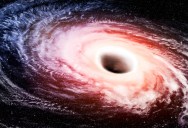What Are White Holes And How Are They Connected To Black Ones?

There’s a good chance that the average person on the street knows what a black hole is – or at least, the very basics.
White holes are more of a lesser-known mystery, but scientists are learning more about them and how they’re related to black holes all the time.
There are two successful scientific theories that help explain a good portion of our universe. The issue that theoretical physics has is that those two theories don’t work well together.
Cutting edge research has looked at ways to reconcile quantum mechanics and general relativity to give us a more accurate picture of the nature of reality.

One of the physicists at the forefront of this research is Carlo Rovelli. He’s written a book called White Holes: Inside the Horizon, and in it, describes what happens when a black hole tries to collapse into nothing.
Instead, it reaches a point where it bounces back, creating a hypothetical object known as a “white hole.”
Rovelli spoke to IFLS about what a white hole would look like, and how he even knows such a thing exists.
White holes are functionally understood as the exact opposite of black holes. If the latter is a plughole, the former is a faucet.
Rovelli says this is accurate.
“The actual full theory of black and white holes is a bit more detailed than just plugholes and faucets. It includes the full spacetime geometry and the dynamics of these spacetimes.”
He also says that to fully understand how white holes come to exist, a person must first understand the physics inside a black hole.
“We always understand things by visualizing them. When scientists began understanding DNA, they immediately made a large-scale model of this molecule to “see” it. When we study a distant planet, we try to imagine what it looks like. Our brain is largely visual and we need imagination for intuiting connections and relations. If I asked you, what does it mean to say that the Earth is round? You would answer: imagine being on the Moon and looking at the Earth. You would see a ball so and so…”
And yes, black holes and white holes look very different – but not always at first.
“If you wait long enough you start seeing the difference: a white hole ends up emitting whatever is inside and disappearing. A black hole emits only a very peculiar form of thermal radiation, at a specific temperature, the “Hawking” temperature. In this way, it “evaporates.”
When a black hole finishes evaporating, it turns into a white hole.
As of right now, though, their existence is only theoretical.
“There is only a possible hint: perhaps the strange substance that the astronomers have observed in the sky which they call “dark matter” might be formed by many small white holes.”
The hypothesis, in fact, is that dark matter is solely made of white holes.

They’re looking to confirm the existence of white holes through observation.
“The best way to confirm the existence of these objects would be to detect one of them flying by here on Earth. There are scientists studying how an apparatus for the detection could work.”
I, for one, can’t wait to see it with my own two eyes.
If you thought that was interesting, you might like to read about a second giant hole has opened up on the sun’s surface. Here’s what it means.

Sign up to get our BEST stories of the week straight to your inbox.




